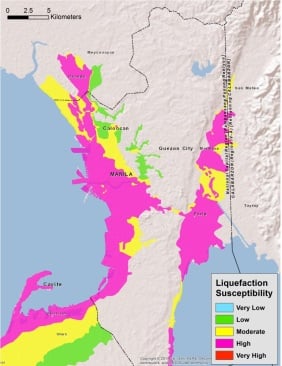Liquefaction caused unprecedented losses in and around Christchurch, New Zealand, during major earthquakes in 2010 and 2011. Thousands of buildings collapsed or were rendered uninhabitable, and most of the infrastructure damage was directly attributed to liquefaction. Since Christchurch, the insurance industry has been asking which other cities are vulnerable to this sub-peril.
There have been many studies, but one area that stands out for liquefaction potential is the National Capital Region (NCR) of the Philippines. It is the most densely populated region of the country and consists of Manila and the Municipality of Pateros, and the cities of Quezon, Caloocan, Las Piñas, Makati, Malabon, Mandaluyong, Marikina, Muntinlupa, Navotas, Parañaque, Pasay, Pasig, San Juan, Taguig, and Valenzuela. With a total population of more than 12 million, the NCR is one of the biggest population centers in Asia.
The Philippines is particularly prone to a variety of natural hazards, earthquake being prominent among them. Southeast Asia is one of the most complex and fastest-deforming seismic zones in the world, with the Philippines located between the Philippine Sea and Eurasian plates—a boundary that is undergoing both subduction and collision.
Some very large earthquakes have occurred in the region, most recently including the M7.8 Lady Caycay quake of 1948, the M8.0 Moro Gulf temblor of 1976, and the M7.7 Luzon earthquake in 1999. Earthquakes up to M7.2 that could produce sizeable losses are anticipated on the West Marikina Valley fault, which runs through the densely populated NCR.
The geological structure of the Metro Manila region consists of three distinct terranes (areas in which a particular rock or group of rocks is prevalent). A study by the Philippine Institute of Volcanology and Seismology (PHIVOLCS) confirms a very high liquefaction potential in the NCR region, mainly in areas like Malabon, Manila, Pasay, Marikina, Pateros, Pasig, and the coastal area of Muntinlupa. Due to its geological composition, the central plateau is mostly not susceptible to liquefaction. The coastal lowland to the west and the Marikina Valley to the east, however, are both highly susceptible.
The coastal lowland is dominated by alluvial deposits of very soft clayey and loose sandy soils up to 40 meters deep near the coast, which reduce in thickness toward Santa Mesa and Makati and contribute to high liquefaction susceptibility is in this region. The deltaic deposition in this area is mostly attributed to the Pasig River, which flows through Manila to the sea. The Marikina Valley in the eastern part of Metro Manila also has widespread quaternary alluvium deposits consisting of very soft clayey and loose sandy soils, and a similarly high liquefaction risk.
According to the AIR Industry Exposure Database, the total insurance exposure in the Metro Manila area is estimated to be around USD 400 billion, and economic exposure is much higher. Masonry construction represents more than 20% of the value of the region's exposure, which can result in very high levels of loss following earthquakes.
Because of their potential contribution to damage in the event of an earthquake, it has become very important to quantify losses due to sub-perils like liquefaction and tsunami for better risk management. This summer, AIR will release updates to the Philippines earthquake and typhoon models, which will include the latest scientific information with respect to modeling shake and wind damage, and enable explicit modeling of sub-perils like liquefaction, tsunami, precipitation-induced inland flood, and storm surge.



